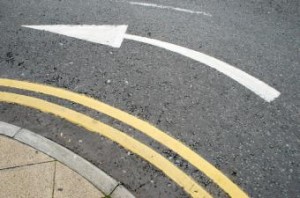After several days of tasting really great wine, I can't lie, you do wonder if you just stacked your cards right or if some level of 'disappointment' might not be that far off. Then again, if it was to come, I knew it wasn't coming at the hand of Wagner Stempel!
 We landed in the northern part of the Rheinhessen as the sun broke through the clouds "officially" and some more late-springlike (n-o-t summer) warmth with it. Tromping through the much more rolling hills/vineyards in these "conditions" was a treat. Assistant Winemaker Oliver Mueller was our guide, providing tremendous insight about their more Burgundian-like spot within the Rheinhessen appellation as well as the non-Riesling grapes they cultivate (though, of course, Riesling does have a very large presence, too). Silvaner, Weissburgunder (Pinot Blanc), Grauburgunder (Pinot Gris), Sauvignon Blanc, Merlot and (of course) Spaetburgunder (Pinot Noir) all have a home here.
We landed in the northern part of the Rheinhessen as the sun broke through the clouds "officially" and some more late-springlike (n-o-t summer) warmth with it. Tromping through the much more rolling hills/vineyards in these "conditions" was a treat. Assistant Winemaker Oliver Mueller was our guide, providing tremendous insight about their more Burgundian-like spot within the Rheinhessen appellation as well as the non-Riesling grapes they cultivate (though, of course, Riesling does have a very large presence, too). Silvaner, Weissburgunder (Pinot Blanc), Grauburgunder (Pinot Gris), Sauvignon Blanc, Merlot and (of course) Spaetburgunder (Pinot Noir) all have a home here.
Walking up through the vineyards was more like meandering, compared to the Mosel and Rheingau's much steeper slopes. Oliver was incredibly passionate - and gave some great insight about their organic approach, explaining how their practices came about and demonstrating with his large visual aids (the vineyards themselves) how their practices lead to healthier vines and, therefore, better fruit for winemaking. (You could see their neighbor's adjacent vineyards were flagging comparatively- why they didn't follow suit bewildered us.) Stempel's philosophy, like so many of our hosts already, is that wine is made in the vineyards first.
We met lead winemaker and owner, Daniel Stempel, back at the winery in their gorgeous open courtyard to sample the wines. Daniel and Oliver are clearly on the same page, as Daniel led with the same thought - that he enjoys his work in the vineyards most - and that that was where the wine was made. Wine after wine tasted, nuances were more fruit-driven and the minerality more warming; think of it this way - the minerality in the Mosel was like icicles hanging off the eaves like daggers; in the Rheingau these were just starting to melt, with softer edges; and at Stempel the crisp, fresh water was running through our fingertips like a narrow-running brook's waterfall edge - forcefully, yet softly. Compelling? No doubt. Another three-hour appointment slipped by as the daylight hovered in the hills.
 The next day took us yet still farther South. We had an appointment at Dr. Heger/Weinhaus Heger after lunch with winemaker Markus Mleinek in the Kaiserstuhl region, Baden particularly. Markus started our tour in the cellars, where it was self-evident that this was an operation that valued tradition and the importance of showcasing terroir in wine, as much as they did innovation. Markus even shared that they experimented once with American oak, which to my knowledge is virtually unheard of in traditional "Old World" winemaking regions, save parts of Spain and Portugal. American oak is known for supplying a bold "marinade" in wines both texturally and in flavor profile (a post for another day); Markus chuckled at the thought, noting that the wine which resulted was "too loud", so they moved on. Stainless steel tanks in one part of the cellar - different sized (and different origin) wood barrels in others. Different projects command different vessels - having the capacity (and need!) to cope is another feat entirely.
The next day took us yet still farther South. We had an appointment at Dr. Heger/Weinhaus Heger after lunch with winemaker Markus Mleinek in the Kaiserstuhl region, Baden particularly. Markus started our tour in the cellars, where it was self-evident that this was an operation that valued tradition and the importance of showcasing terroir in wine, as much as they did innovation. Markus even shared that they experimented once with American oak, which to my knowledge is virtually unheard of in traditional "Old World" winemaking regions, save parts of Spain and Portugal. American oak is known for supplying a bold "marinade" in wines both texturally and in flavor profile (a post for another day); Markus chuckled at the thought, noting that the wine which resulted was "too loud", so they moved on. Stainless steel tanks in one part of the cellar - different sized (and different origin) wood barrels in others. Different projects command different vessels - having the capacity (and need!) to cope is another feat entirely.
 Our vineyard tour was also astounding. In the distance the Rhine river - and France! - terraces of unique volcanic soil lay in front of us. Here, too, they employ various techinques to mitigate using too many chemicals in the vineyards. The wine bottles hanging on the line PICTURED RIGHT are filled with sugar water, to keep pests elsewhere and harmony happening naturally in the vineyards! Brilliant for its simplicity and effectiveness.
Our vineyard tour was also astounding. In the distance the Rhine river - and France! - terraces of unique volcanic soil lay in front of us. Here, too, they employ various techinques to mitigate using too many chemicals in the vineyards. The wine bottles hanging on the line PICTURED RIGHT are filled with sugar water, to keep pests elsewhere and harmony happening naturally in the vineyards! Brilliant for its simplicity and effectiveness.
Heger's projects are many, hence the two names on the door: Dr. Heger/Weinhaus Heger. Dr. Heger is the elite-most line, Weinhaus Heger just below on the totem pole - and Fischer a special project we were just as happy to sample featuring a collaboration with a local cooperative of wine growers where they invest knowlege as much as any other resource to ensure quality grapes are grown. We tasted 30 some wines this afternoon, each as compelling as the next, more than respectworthy for its unique place in the Heger "family" of offerings. Yes, the spit bucket needed to be relieved several times to accomodate our 'thirst' to sample as much as possible with Marcus.
What was particularly interesting is that here in Baden red grapes have an important presence - although the white lineup was more than compelling in itself. Not one Spaetburgunder failed to deliver, and we tasted several back vintages of current wines - as these delicious treats can certaily age! Smoked meats, fresh pink roses, violets, volcanic soil, ripe black cherry fruit comingling with tart pomegranate and boysenberry exploded in various proportions from the glass; finesse met power with perfect elegance, and a picture was painted on a virtual timeline, showcasing anticipated versions of perfection as the individual wines showed that day, and would again at various points in the future.
Yes, it was a helluva way to end the formal portion of our tasting adventures. Back here at home I realized I learned more in Germany than on any other wine trip (so far). No doubt I had the most to learn, and therefore the most to gain. It didn't hurt that the appointments I had, and the recommendations from winemakers we enjoyed meeting, were spot on. If you're going to do a whirlwind wine country tour inside of a week, this was the way to do it! Literally it was a sampling of German wine regions. I guess I'll have to go back!


 After two full days in the Mosel it was time to go vineyard/region-hopping as we drove South through German wine country. To save time on the way to our first appointment in the Rheingau, about two hours from the Mosel, we took a car ferry (so cool!) across the Rhine River. It deposited us on the other bank just down the slope from Josef Leitz's winery. (Perhaps starting with the ferry experience itself, the visit at Leitz offered not just great wine tasting, but also a terrific lesson in German history - e.g. ferries keep transport efficient and fluid, as many key bridges were destroyed in World War II).
We found Johannes Leitz (said "Lights" - the winery is named for his father Joseph, who died when Lietz was only 2 years old) with his gardening gear on, wheelbarrow in hand. He quickly terminated his home gardening duties, ushered us into his immaculate tasting room and jumped right into a detailed discussion about the Rheingau; terrific photos told the story of its unique terroir, including the microclimates and varied soil types that 'co-exist' just meters from each other. (I HIGHLY encourage you to visit his
After two full days in the Mosel it was time to go vineyard/region-hopping as we drove South through German wine country. To save time on the way to our first appointment in the Rheingau, about two hours from the Mosel, we took a car ferry (so cool!) across the Rhine River. It deposited us on the other bank just down the slope from Josef Leitz's winery. (Perhaps starting with the ferry experience itself, the visit at Leitz offered not just great wine tasting, but also a terrific lesson in German history - e.g. ferries keep transport efficient and fluid, as many key bridges were destroyed in World War II).
We found Johannes Leitz (said "Lights" - the winery is named for his father Joseph, who died when Lietz was only 2 years old) with his gardening gear on, wheelbarrow in hand. He quickly terminated his home gardening duties, ushered us into his immaculate tasting room and jumped right into a detailed discussion about the Rheingau; terrific photos told the story of its unique terroir, including the microclimates and varied soil types that 'co-exist' just meters from each other. (I HIGHLY encourage you to visit his  The first stop on our tour was the Mosel - probably the most well-known German wine producing region, and best known for its Riesling. I've joked that I would never want to work harvest in the Mosel because the slopes are so bloody steep and narrow that I would put down my bucket of grapes (hand-harvesting is the only way to do it as no machine could manage the incline) and accidentally kick it over with my foot, sending hundreds of dollars down the hill with it. Having been there now, I can say that even as a fairly agile human, I would definitely not sign up first for the task. And it is oh-so-precious fruit indeed.
The first stop on our tour was the Mosel - probably the most well-known German wine producing region, and best known for its Riesling. I've joked that I would never want to work harvest in the Mosel because the slopes are so bloody steep and narrow that I would put down my bucket of grapes (hand-harvesting is the only way to do it as no machine could manage the incline) and accidentally kick it over with my foot, sending hundreds of dollars down the hill with it. Having been there now, I can say that even as a fairly agile human, I would definitely not sign up first for the task. And it is oh-so-precious fruit indeed. AJ Adam was next on our Mosel tour - a recommendation from Konstantin Weiser on Day 1 of the trip. We took our chances and popped by, catching Andreas coming home from the vineyards by tractor for a little lunch break. Two hours later we had tasted a delicious (ample) sampling of Rieslings from his portfolio. A family resemblance was present among these wines also - a ripeness of fruit cut with nearly searing acidity and a wet-stone-meets-talc-like minerality texture on the tongue. These wines were compelling for their sleek precision - yet elegance!
AJ Adam was next on our Mosel tour - a recommendation from Konstantin Weiser on Day 1 of the trip. We took our chances and popped by, catching Andreas coming home from the vineyards by tractor for a little lunch break. Two hours later we had tasted a delicious (ample) sampling of Rieslings from his portfolio. A family resemblance was present among these wines also - a ripeness of fruit cut with nearly searing acidity and a wet-stone-meets-talc-like minerality texture on the tongue. These wines were compelling for their sleek precision - yet elegance!




